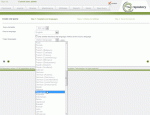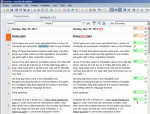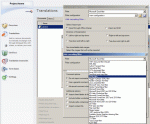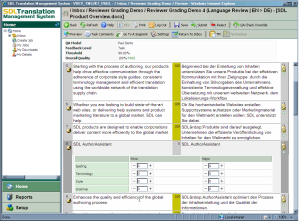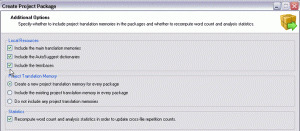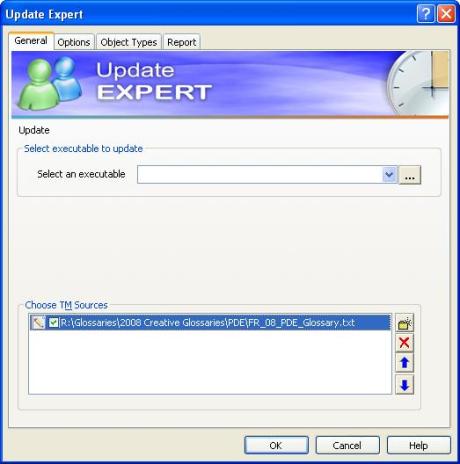
I have been trying to diversify the topics we cover on LocLoc; and especially the tools we talk about. It started recently with a QA tool and now continues with a CAT tool. I already know from the survey I’ve had on this page, that a lot of you are familiar with Kilgray’s memoQ. This, is a preview of what to expect from the forthcoming memoQ4, from the mouth of Kilgray’s COO, István Lengyel.
[Nick Peris] Hi István, could you introduce Kilgray and your role within the company?
[István Lengyel] Hi Nick! Thanks for inviting me to do this interview. Kilgray Translation Technologies is an independent company dedicated to the development of clean and innovative tools for translation, but so far we are by far the best known for our memoQ translation environment. Though we are based in Hungary and all the founders are Hungarians, we became quite an international team in the last two years, opening up in Germany, Poland and now in the US. It’s really great to work in this team, as we have people coming from all sorts of companies such as Idiom, Passolo, SDL Trados, etc., and every addition to the team opens up new perspectives and shows new approaches – the company culture builds on respect and cooperation.
I am one of the architects of memoQ and also the chief operating officer at Kilgray, though in reality I’m mostly managing our sales and marketing team and our international expansion.
[Nick] Could you give a general overview of what memoQ is for readers who are not familiar with it?
[István] memoQ is an integrated translation environment that has a couple of focal points. First, it is easy to use, easy to learn. Second, we translate a lot in it and manage memoQ’s localization in memoQ itself, so we developed an eye for details – there are lots of smaller features that really make life easier. Third, from the very beginning we were concentrating on collaboration, and even the first version included an internet-enabled TM/TB server. Fourth, we don’t believe that we should lock in any of our customers – the entire system supports interoperability between tools to the maximum extent, meaning that you can process files prepared by virtually any major translation tool, and you can also prepare files for processing in other tools. There’s also a full set of documented APIs available for integration with other tools. Fifth, leverage, which means that we are trying to make the most of your resources. There were a couple of things where memoQ pioneered: we were the first to introduce real-time previews that change as you type, we were the first to introduce communication such as knowledge bases and instant messaging and offline synchronization into a translation memory server, we were the first to introduce the translation memory-based segmentation where pre-translation emulates the way your translators join and split segments, and we were the first to introduce the automated concordancing. But quite frankly, we are just as happy to take over things that work from other tools as we are to introduce new stuff.
[Nick] I know you are preparing to release a new version; could you give us a release date for memoQ 4?
[István] A few days ago we named January 31, 2010 for the release date, but I was reminded that it’s a weekend. So the first week of February. (Well, who cares about weekends? :))
[Nick] What are the main changes from memoQ 3.5 and main reasons to upgrade?
[István] There are so many changes that I can hardly list them! memoQ 4 is the first memoQ version that really focuses on project management. We like to build bottom-up and believe that an organization will only have a good experience deploying a tool if the translators like it, and we spent the last five years making the translators happy. So let’s start with the revolutionary feature: post-translation statistics. Imagine a situation where several people are working on the same set of similar documents, using a server-based translation memory. There can be a lot of fuzzy matches coming from the other translator’s translated entries, but so far there was no way in any tool to enumerate these matches, because the person who starts working later gets more matches than the person who is the first to start. memoQ 4.0’s post-translation statistics will solve this Gordian knot, and give you the actual fuzzy match analysis for every translator after the project. This way finally there is a business model for server-based translation.
Other than this, the biggest change is that we have upgraded the concept of translation memory servers to the concept of resource servers. So far you could share translation memories, term bases and documents between translators, and you could set up projects for them centrally. In the new version, you can share every other resource such as auto-translatables (for people used to Trados lingo: customizable placeables), non-translatables, segmentation rules, QA settings, keyboard shortcut settings, ignore lists for the spell checker and so on – 12 of them, all together. What’s more, sharing this happens in the background so you can start the publication of a big TM on the server and go on managing other projects in the meantime. These resources can all be exported into an XML-based format so clever project managers can prepare them also automatically.
memoQ 4 also brings finally the concept of multilingual projects. You can create handoff packages and receive delivery packages, or you can simply publish a project on the server. Those who receive the handoff package can in turn create new handoff packages (handy for a multi-tier enterprise-MLV-SLV-translator setup), and through delivery the files and reports are updated automatically. The handoff packages are just zipped containers of open-source format data – XLIFF for documents, TMX for TMs and CSV for terminology. You can process the packages in any tool, so the users are not locked in.
Compared to these improvements, the brand new text editor, the completely revamped user interface and the streamlined quality assurance seem small. Even the previous version of memoQ got quite a lot of credits for its good support of bidirectional and CCJK languages, memoQ 4 takes this further and also introduces support for Indic languages. We are introducing a very advanced multi-tier undo/redo logic, real-time spell checking and other minor improvements. The quality assurance checks have also been dramatically improved and also the interface for fixing warnings has been fine-tuned.
And I failed to mention so many things! memoQ 4 is the single biggest upgrade memoQ ever received.
[Nick] For non-memoQ users, could you give us the main reasons to switch to memoQ 4?
[István] Because other people do and they are happy about it! 🙂 Just like every company, we make mistakes at times but there has not been any single case that anybody asked for a refund. Seriously, I think the main reasons to switch to memoQ are collaboration, interoperability and support. memoQ is a truly collaborative application, it is one of the few tools that enable simultaneous translation and proofreading on the same document, complete configuration of projects for your translators, or using several translation memories or term bases that can be local, remote — they can even be on different servers — or offline synchronized. The server is fast even on a HSDPA connection and it’s also very affordable – no wonder we have over 150 servers out there.
The other important aspect is interoperability. Our main market is language service providers, and an LSP can never say that they use only a single tool, period, otherwise they lose business and what’s more, they can also lose translators. With memoQ you can process documents and packages created by other tools, and you can prepare packages in industry-standard formats for other tools too. Therefore you don’t find yourself in a situation that you bought the tool because you liked it and then you have to fight with everyone around you to make it accepted.
And the third most important aspect is support. I think Kilgray’s support is just great – fast, focused and friendly.
[Nick] What is the pricing structure for memoQ 4?
What are the different Editions of memoQ 4?
[István] memoQ 4 comes in three client editions: translator standard, translator pro and project manager.
memoQ translator standard is for those translators who never work in teams. It does not enable access to servers and does not enable export of files into XLIFF or bilingual DOC, only memoQ’s proprietary MBD format. It also lacks the ContexTM (101%) matching which takes the context also into account, and comes without support. But the price tag is attractive: 99 euros a year.
The memoQ translator pro is the edition for professional translators and very small translation companies who don’t want to invest into a server solution. It costs 620 euros.
The memoQ project management edition comes with multilingual project management and reporting functionality and we charge around a thousand euros for that.
When it comes to server technology, we sell our solution with mobile (ELM or floating) licenses, meaning that companies can give away and take back licenses to translators over the internet. The initial package contains five mobile licenses, and we sell additional bundles of five licenses at very competitive prices. When it comes to servers, we prefer not to sell without a trial period of 30 days – we want everybody to use the tool, not just buy it for the drawer.
[Nick] How did you take into consideration user feedback during the development of memoQ 4?
[István] Oh I could name the people who contributed with their user feedback here! I think it’s worth mentioning how we work. Basically there are four people who decide on what gets into the next release, and every release has a theme. These themes are contained in our 5-year roadmap and we regularly come together for things that we call “walk in the woods”‘ – creative sessions outside the office where we discuss the main ideas and concepts. We personally talk a lot with users and try to learn the rationale behind their feature requests. These talks shape the main themes/features a lot. On top of that, we have a system to archive all the threads on feature requests, and we go through these regularly. I could give you a rather precise list of features for the next three versions!
So basically the user feedback is taken into consideration on two levels: when we realize that a business problem is hard to solve with memoQ, we incorporate the solution into the high-level concepts. The other level is the feature level where for example users request amendments to file filters or suggest small usability improvements. If these are justified, these can go straight into the feature overview.
[Nick] How is Terminology Management undertaken in memoQ 4? What are the Termbase formats supported?
[István] Terminology management is one of the most controversial components in memoQ! So far we only support CSV and – surprise-surprise – TMX as import formats and can also export into Multiterm XML. Why TMX? Just think about software localization and then the help and you’ll understand. With memoQ we decided that this is a translation tool and not a terminology application, and therefore we gave a finite set of attributes but something that is pretty comprehensive: you can have synonyms, definitions, notes, grammatical information, contexts, project, domain, subject, client information, and a few other fields. You can also have images in the term base, and forbidden term variants can also be flagged. From the workflow point of view, memoQ has had a term base moderation feature since v2.0 in 2006, which means that terminologists may need to approve all terms suggested by translators before they become final. Terminology matching is really exciting: you can use wildcards to indicate the end of the invariable part of every word in a term, i.e. for a language like Spanish you can enter cinturón* de seguridad and that will also find cinturónes de seguridad. For translators of Slavic languages this is really crucial (fuzzy matching does not always work for terms). I can list quite a few pros for memoQ’s terminology management but I must say that it’s a very practical approach. However, we understand that corporate terminology management is not a subset of translation, and terminologists may need some more freedom.
Expect that freedom in a third-party tool based on the memoQ engine soon.
[Nick] Is there anything specific to memoQ in the way Translation Memories are created and maintained?
[István] Translation memories are by default context-enabled in memoQ, and memoQ supports two kinds of contexts: the segment before and after and context bound to structural information. This latter means that if you have for example the software strings in an XML or Excel file, with an attribute indicating where the text appears, you will get a 101% match if the attribute is the same to the attribute where you originally entered this translation – this way you can shuffle the translatable strings and still keep the context information. If you speak the Idiom lingo, this is very similar to ICE and SPICE matching.
As for maintenance, there are a couple of things that are quite unique. First, a 100% or 101% match for us is only a match that is identical both in content and formatting to the original. But we have a special bracket, 95-99% that contains segments where numbers, formatting, whitespaces, punctuation marks can be different. Any change in the text results in something lower than that. You can join and split segments wherever you want, and when you get an update to the document, the TM-driven segmentation will automatically join and split the segments according to your previous translation, as it looks into the translation memory for better matches through joining and splitting. During pre-translation, cases where you get multiple 100% matches (because you translated the segment differently in two contexts, and this third context is unknown so far) are flagged and they are very easy to locate. All these features fall under the umbrella term we use for design: “reproducibility”. I think it’s also worth mentioning that memoQ has a built-in TM editor and can work with as many TMs at a time as you wish. Oh, and yes, a minor nuance, just to make things elegant and please those who are really tech-savvy: our support for TMX also covers attributes, so if you import a TMX file coming from another tool that has attributes, even if the TMX attributes there cannot be displayed in memoQ, you can expect that the TMX export from memoQ will preserve and contain them – so memoQ does not swallow the information that it cannot process.
[Nick] Is there any new feature in memoQ 4 you are particularly fond or proud off? Maybe some anecdote about features which took you a lot of efforts to achieve and which you are now very happy to bring to memoQ 4 users?
[István] Well, I’m a person who prefers the big picture to the small details, and for me the biggest achievement – and a big praise goes to Gábor Ugray, our head of development who designed these features – is that the tool did not get more complicated for translators according to the feedback of those users whom we showed the system. We always pay a lot of attention to the user interface, but when we started conceptualizing memoQ 4 about two years ago, keeping its simplicity seemed like a daunting task. The visual marker of the entire resource management and multilingual project management feature is now just two drop-down lists: the server selector and the language selector. And I am of course proud of the fact that the resource concept makes the entire system future-proof – no matter what sort of a linguistic resource comes into existence in the next years, we’ve got a place for it, and savvy users are also welcome to write third-party resource managers.
[Nick] We are seeing a merging trend where tools are less specific to either software or documentation. This is partly due to the content types evolution, and partly to an effort by tool developers to become more all encompassing. How does memoQ fit into this? How is your support for software localisation? Also xml and xliff?
[István] I saw this very much in 2005 when we started off but I don’t see it that much anymore. About a year ago or so we implemented visual localization support for RESX files and quite a few users are using it, but we have no plans to implement visual localization for other formats such as RC or binary files. On the other hand there are quite a few considerations in memoQ that make it a very good tool for localizing Help content. I already mentioned the TMX import into the term base and the support for context based on another column in the Excel file or an attribute in the XML file, I’d like to mention the automated concordancing feature that was inspired by one of our translation jobs – in our earlier lives as translators – where TM management (another issue I could talk about for hours) was virtually non-existent. I don’t want to name the end-client and the LSP we got this from (they are both very reputable and well-known in localization), but basically to translate the help of version 8 of a well-known application we only got a TM that contained version 2 to 7 of the same application. No terminology, no localized software strings for version 8, nothing. We spent hours to find out what screen caption has been translated before and what expressions did we have to coin, because – as it is with software – quite a few of them were 8-10 words long, and of course developers make changes to these every now and then, changing one or two words maximum, adding a few words to the end, etc. The automated concordance automates this manual process: it automatically gives you the longest multiword expressions that appear at least a given number of times in the translation memory. It does not give you the translation in most cases, but if you select it, it opens the concordance window with the right expressions. And yes, the concordance can look for a series of words. So basically we don’t want to take away business from the excellent software localization tools, but we definitely want to be the best technology for translating help and manuals.
[Nick] Do memoQ and Kilgray offer workflow technology allowing supplier and clients in the localisation chain to work together online?
[István] Our workflow is a linguistic one, and not a highly structured one. We coined two terms. For us, horizontal workflow means when people work together on the same task. Vertical workflow is the traditional workflow, passing along the files between different people doing different jobs. memoQ is excellent in helping people work together on the same task and has a lot of workflow tools such as moderated term bases, simultaneous translation and proofreading, different forms of review, communication and knowledge bases, etc. From the point of view of traditional workflows, we only cover translation and review – items that happen within the tool. There’s no way to integrate things like source text review, DTP or settlements into memoQ. However, the extensive set of APIs enable integration with workflow tools, and at this point I have to mention that both Beetext Flow and Plunet Business Manager do a great job when it comes to deep integration. They can both take care of the entire process, and generate and maintain the projects automatically in memoQ. One of the things we are putting a lot of emphasis on nowadays is client review. I think memoQ is one of the best tools for this, but there is still a lot of room for improvement.
[Nick] Could you say a few words about the memoQ support network? How can new users avail of the experience of other users and if necessary receive support from Kilgray directly?
[István] Here are a couple of interesting resources: http://rc.kilgray.com – the Resource Center that contains training videos, guides, filter configurations for XML-based file formats, but also interesting articles on general topics such as TM management, technology purchase pitfalls, etc. for people and companies not using memoQ.
The memoQ Yahoo! Group (http://tech.groups.yahoo.com/group/MemoQ/) offers the expertise of other users but we also contribute often, and hey, you have the best experts of the competition also there and they often contribute too.
There is a memoQ wikibook too, and the forums on proz.com and other sites can also be interesting.
If direct support is required, it’s primarily through our support email address – please don’t publish the address directly on your website, we don’t want more spam there, but it’s at kilgray.com.
[Nick] Is it too early to ask you about roadmap? What are you plans for memoQ?
[István] It’s not too early at all, but I’m afraid I can’t tell much about the big improvements at this point. One thing is for sure – after 4.0, we will relax a bit and iron out any rough edges that may have remained in this brand new tool. One of the things that many users asked for and will be there in 4.1 (or whatever the final version number will be) is the bilingual DOC table format for review with comments. But one thing is for sure, you can expect another major version with a huge new resource in 2010.
[Nick] This has been a very informative interview. I thank you for your time and detailed answers and look forward to reviewing memoQ4 in the new year!
 SDL have been drumming up interest for SDL Trados Studio 2011 through the summer. Eventhough the successor to SDL Trados Studio 2009 is announced to release at the end of September, I must admit that I have been slower to turn my attention to it than I was with Studio 2009.
SDL have been drumming up interest for SDL Trados Studio 2011 through the summer. Eventhough the successor to SDL Trados Studio 2009 is announced to release at the end of September, I must admit that I have been slower to turn my attention to it than I was with Studio 2009. Studio 2011 uses a change tracking technology which is fully compatible with Microsoft Word. Thanks to the SDL XLIFF Converter, an SDL Open Exchange add-on now included in Studio, changes and comments made in Trados can be viewed, accepted etc. in Microsoft Word and vice versa.
Studio 2011 uses a change tracking technology which is fully compatible with Microsoft Word. Thanks to the SDL XLIFF Converter, an SDL Open Exchange add-on now included in Studio, changes and comments made in Trados can be viewed, accepted etc. in Microsoft Word and vice versa.
 QA Checker 3.0
QA Checker 3.0 Starting a project itself is a simpler process, with only 3 files needed (source, bilingual and TM), and no associated folder structure in the background.
Starting a project itself is a simpler process, with only 3 files needed (source, bilingual and TM), and no associated folder structure in the background.







